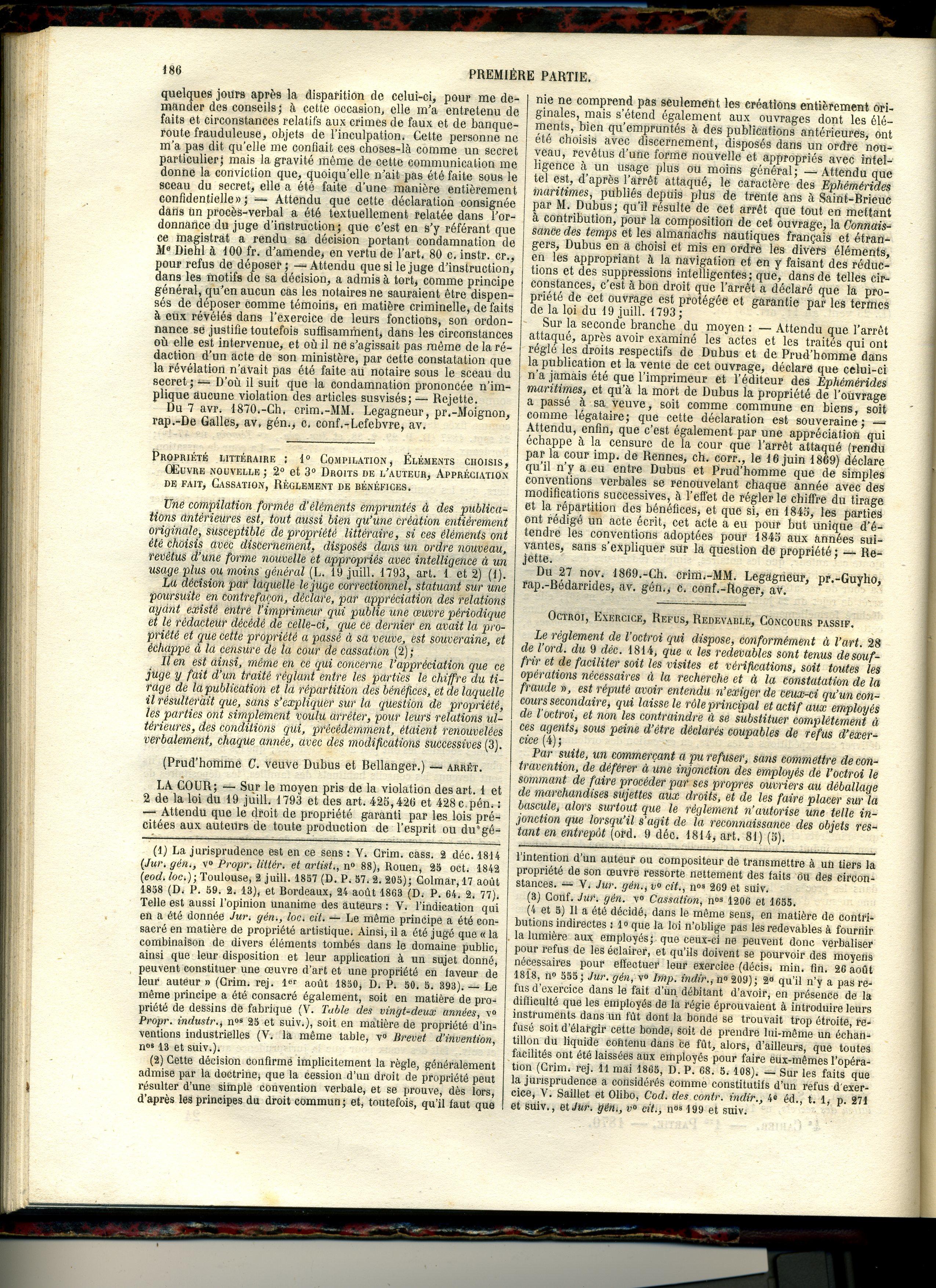Browse Documents By...
Original Language...
Documents For...
Browse Commentaries By...
Browse Referred Persons By...
Court of Cassation on originality, Paris (1869)
Source: Bibliothèque universitaire de Poitiers (SCD) : Dalloz, Jurisprudence générale. Recueil Périodique et critique de jurisprudence, de legislation et de doctrine, 1870.1.186
Citation:
Court of Cassation on originality, Paris (1869), Primary Sources on Copyright (1450-1900), eds L. Bently & M. Kretschmer, www.copyrighthistory.org
Back | Record | Images | Commentaries: [1]
Translation only | Transcription only | Show all | Bundled images as pdf
186 FIRST PART
[1st column:]
[...]
___________
LITERARY PROPERTY; 1º COMPILATION, CHOSEN ELEMENTS,
NEW WORK; 2º and 3º RIGHTS OF THE AUTHOR, ASSESSMENT
OF THE CASE, CASSATION, REGULATION OF PROFITS.
A compilation made up of elements which have been borrowed from
previous publications is, just like an entirely original creation,
susceptible of literary property, if the elements have been chosen
with discernment, placed in a new order, invested with a new
form and intelligently made available for a more or less general use
(Law of 19 July 1793, art. 1 and 2)
[...]
(Prud'homme v. Dubus's widow and Bellanger) - DECISION.
THE COURT; — [...] Whereas the right of property guaranteed by the
aforementioned laws to the authors of all productions of the mind or
[2nd column:]
of genius covers not only entirely original creations, but extends also
to those works whose elements, though borrowed from previous publications,
have been chosen with discernment, placed in a new order, given a new
form and intelligently made available to more or less general use; - Whereas
such is, according to the contested decision, the character of the "Maritime
Compendium", published for the last thirty years at Saint Brieuc by
M. Dubus; and it follows from this decision that in using for the composition
of this work "La Connaissance des temps" and various French and foreign
nautical almanacs, Dubus selected and ordered the various elements, making them
useful to navigation and carrying out intelligent reductions and excisions; and,
under such circumstances, the decision was correct in declaring that this work
is protected and safeguarded under the terms of the law of 19 July 1793.
[...]
The Court rejects the appeal.
On 27 November 1869. - Criminal Chamber - Messrs Legagneur, President -
Guyho, Reporter - Bédarrides, Attorney General, c. conf. - Roger, lawyer.
______________
No Transcription available.
Source: Bibliothèque universitaire de Poitiers (SCD) : Dalloz, Jurisprudence générale. Recueil Périodique et critique de jurisprudence, de legislation et de doctrine, 1870.1.186
Citation:
Court of Cassation on originality, Paris (1869), Primary Sources on Copyright (1450-1900), eds L. Bently & M. Kretschmer, www.copyrighthistory.org
Back | Record | Images | Commentaries: [1]
Translation only | Transcription only | Show all | Bundled images as pdf
[1st column:]
[...]
LITERARY PROPERTY; 1º COMPILATION, CHOSEN ELEMENTS,
NEW WORK; 2º and 3º RIGHTS OF THE AUTHOR, ASSESSMENT
OF THE CASE, CASSATION, REGULATION OF PROFITS.
A compilation made up of elements which have been borrowed from
previous publications is, just like an entirely original creation,
susceptible of literary property, if the elements have been chosen
with discernment, placed in a new order, invested with a new
form and intelligently made available for a more or less general use
(Law of 19 July 1793, art. 1 and 2)
[...]
THE COURT; — [...] Whereas the right of property guaranteed by the
aforementioned laws to the authors of all productions of the mind or
[2nd column:]
of genius covers not only entirely original creations, but extends also
to those works whose elements, though borrowed from previous publications,
have been chosen with discernment, placed in a new order, given a new
form and intelligently made available to more or less general use; - Whereas
such is, according to the contested decision, the character of the "Maritime
Compendium", published for the last thirty years at Saint Brieuc by
M. Dubus; and it follows from this decision that in using for the composition
of this work "La Connaissance des temps" and various French and foreign
nautical almanacs, Dubus selected and ordered the various elements, making them
useful to navigation and carrying out intelligent reductions and excisions; and,
under such circumstances, the decision was correct in declaring that this work
is protected and safeguarded under the terms of the law of 19 July 1793.
[...]
The Court rejects the appeal.
On 27 November 1869. - Criminal Chamber - Messrs Legagneur, President -
Guyho, Reporter - Bédarrides, Attorney General, c. conf. - Roger, lawyer.
No Transcription available.





